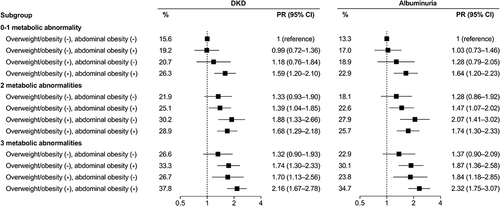Figures & data
Table 1 Characteristics of the Study Population with and without DKD
Table 2 Prevalence Ratios (95% CIs) of DKD According to BMI and WHR Categories
Table 3 Prevalence Ratios (95% CIs) of DKD According to Obesity Patterns
Table 4 Associations of BMI and WHR Categories and Metabolic Status with Prevalent DKD
Figure 1 Associations of obesity patterns and metabolic status with prevalent DKD and albuminuria. Patients were divided into 12 groups based on the cross-categorization of overweight or obesity and abdominal obesity and the number of metabolic abnormalities. The model was adjusted for age, sex, education, smoking status, alcohol drinking, diabetes duration, HbA1c, and use of antidiabetic agents. Patients who had normal BMI without abdominal obesity and 0–1 metabolic abnormality were regarded as the reference group.

